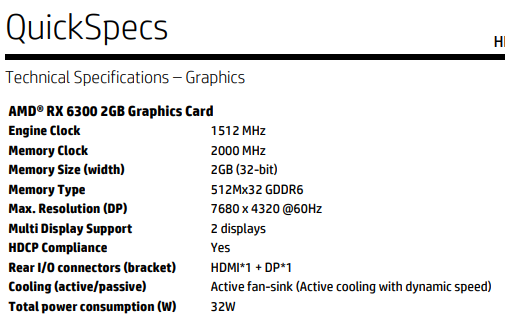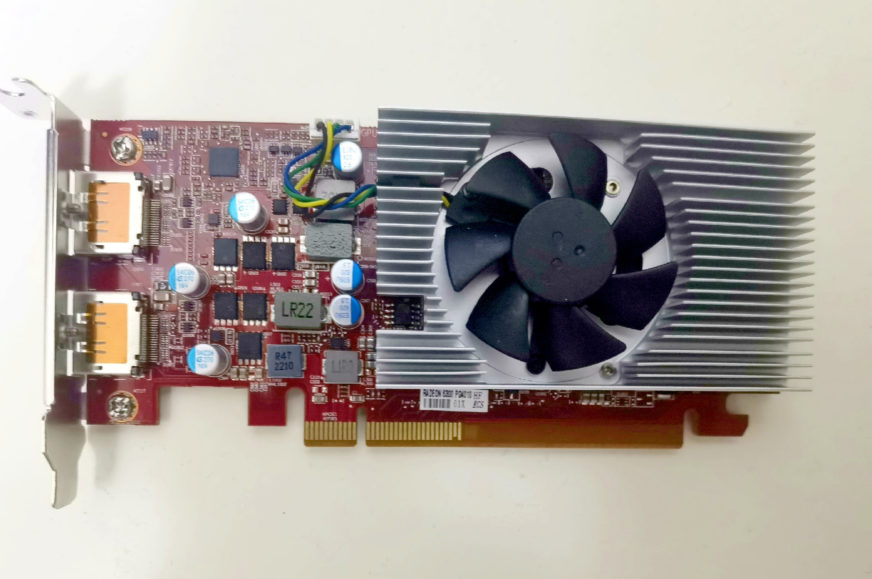New 32W low-end graphics card with AMD RDNA 2 architecture
Basic low-cost dedicated GPUs became a dying breed over the last decade. Faster integrated GPUs leave less and less room for them and it doesn’t pay off to develop new chips of this sort anymore. Nvidia has been selling the GeForce GT 1030 with a 16nm Pascal architecture chip for almost six years now, and it’s only now, it seems. that a more modern replacement could appear: the Radeon RX 6300 with a 6nm GPU based on a current architecture.
The Radeon RX 6300, a hitherto unannounced card, has popped up for sale in China on the Goofish internet marketplace. AMD hasn’t officially announced this model, so it’s a question how commonly will it be available on the market. However, in the previous generation, there was a Radeon RX 5300 model for the OEM sector. It’s likely that these cards may have been destined for OEM PC setups as well, but now the surplus is making its way to the open market.
The Radeon RX 6300 as a desktop card is apparently very similar to the low-end Radeon RX 6300M for laptops, which was introduced in January 2022. So the card is based on the same 6nm Navi 24 chip that is found in the Radeon RX 6400 and 6500 XT. In this case it is supposed to have 768 active shaders (12 CUs out of 16 physically present) as in the Radeon RX 6400, but at a clock speed of only 1512 MHz – apparently the same as for the mobile RX 6300M.
The major difference to the Radeon RX 6400 will be that the memory is significantly cut down – the card has only a 32-bit bus and 2GB of GDDR6 memory on it. This gives an effective bandwidth of 64GB/s due to it running at 16.0GHz effective clock (the Radeon RX 6400 has a bandwidth of 128GB/s). Both capacity and bandwidth will severely limit any potential for gaming beyond some undemanding and older titles. However, this card is apparently intended for the job of providing mostly just basic functionality for computers that lack integrated graphics and not much more.

The Radeon RX 6300 could indeed serve as a more up-to-date and better replacement for the GeForce GT 1030, as it has similarly low power draw. The TDP has been reduced to just 32W (for comparison, the Radeon RX 6400 has a TDP of 53W, the GeForce GT 1030 with GDDR5 is at 30W). Passively cooled cards should also be possible, but the model that has surfaced in China is fan-cooled. It’s a small, low-profile card with one slot thickness and two outputs (presumably HDMI and DisplayPort – the Navi 24 GPU can ony provide two outputs, so this is silicon limitation). As you can see on the photo, the card only uses a PCI Express 4.0×4 interface, which is again due to the limitations of the Navi 24 GPU.

Considering the current lack of more modern graphics cards in the deep lowend price market segment, it would be nice if this model could be purchased globally. Users who don’t need 3D performance in games, but simply seek a card that will allow them to feed a screen in a computer setup with for example a Ryzen 5000 or a Xeon or Threadripper CPU, wouldn’t be forced to buy the increasingly aging GeForce GT 1030. Iin contrast to that card, the Radeon RX 6300 should support up to 8K monitors via DisplayPort 1.4a or HDMI 2.1. And the drawbacks it has, such as the lack of an AV1 decoder or hardware encoder, also apply to the GeForce GT 1030.
Thanks to the new architecture, there is good chance you won’t see issues with driver availability for a long time, whereas with the GeForce GT 1030 it is quite possible that Nvidia could stop updating drivers within a few years. The Kepler architecture was cut in 2021, and while Maxwell and Pascal are still supported, that may change in a few years. This is a potential problem for low-end graphics, where old architectures often keep selling long after being phased out in the rest of the portfolio, so the RDNA 2 architecture could have an advantage in terms of length of support.
Tip: A graphics you can buy. We’ve tested the Asus GT 1030 SL 2G BRK
Sources: Goofish, Komachi_Ensaka, HXL, VideoCardz
English translation and edit by Jozef Dudáš
⠀








